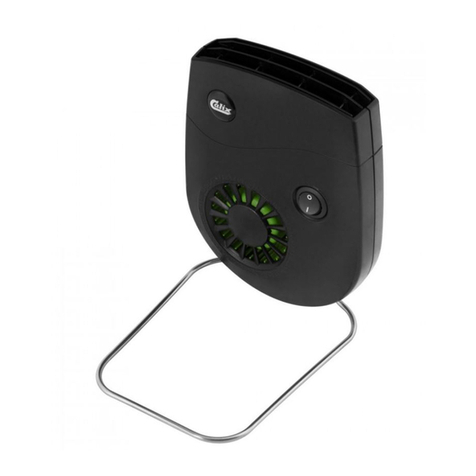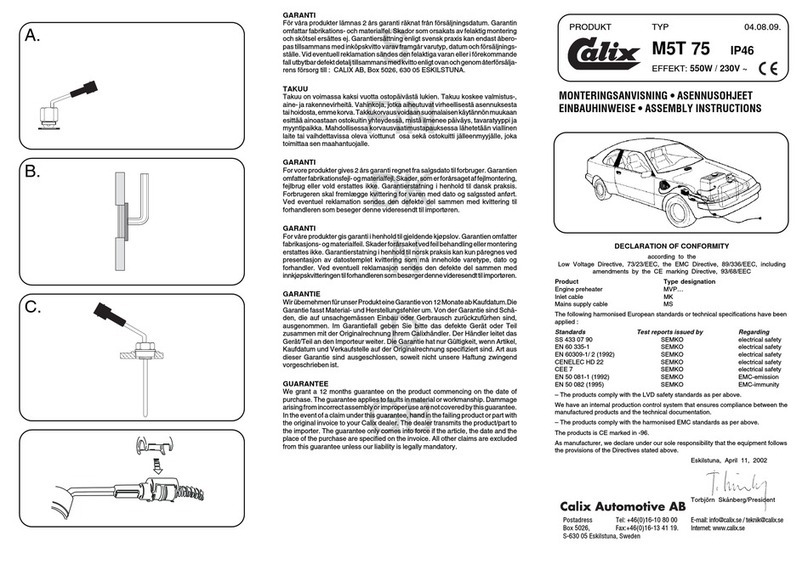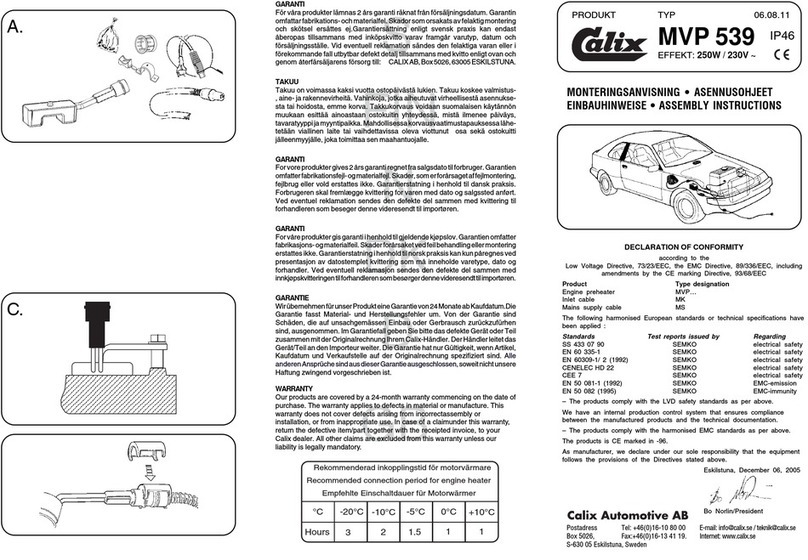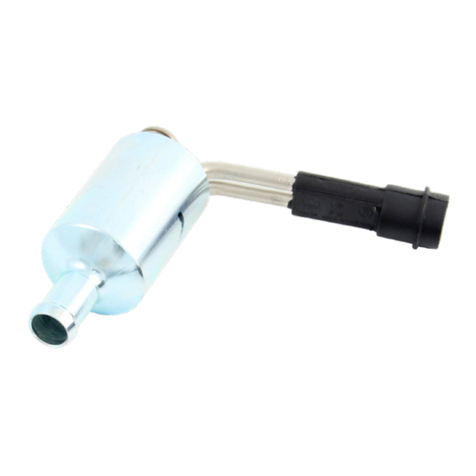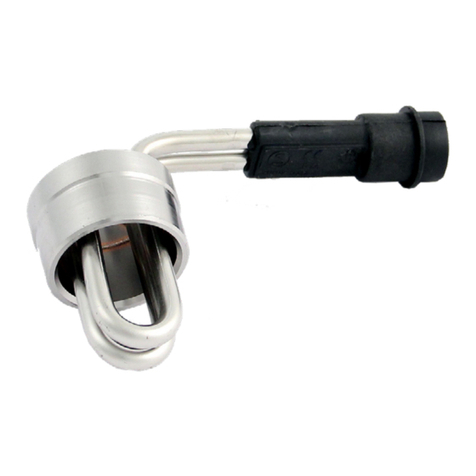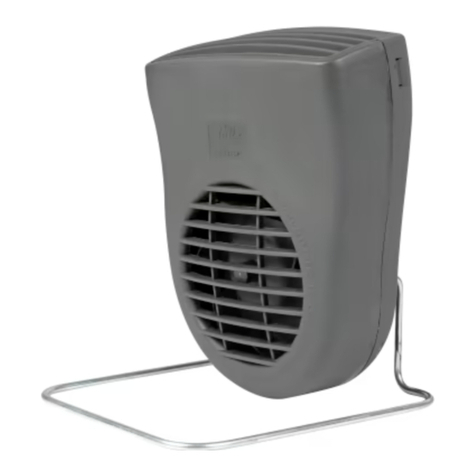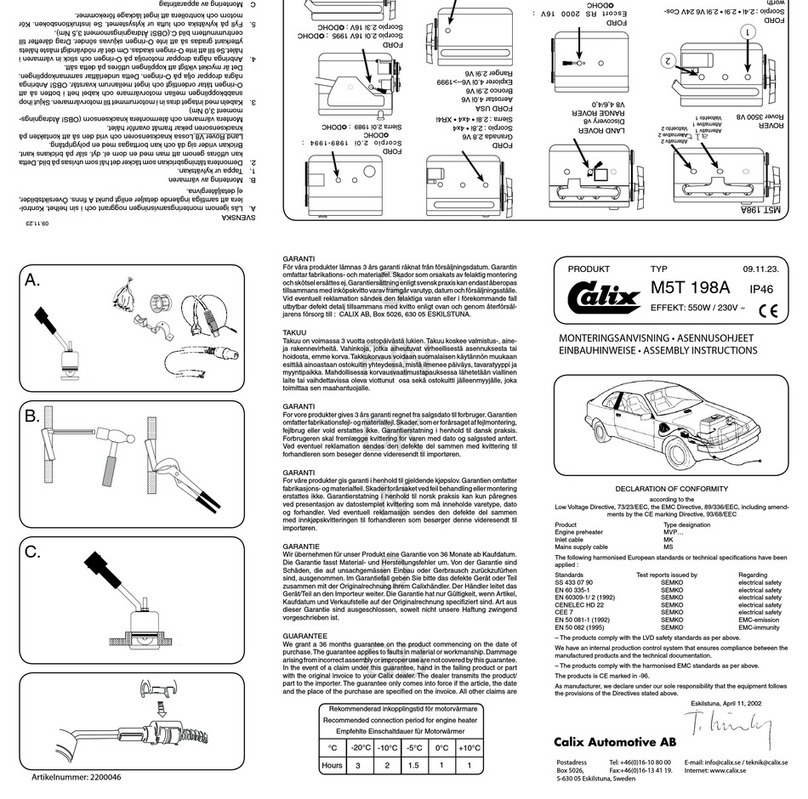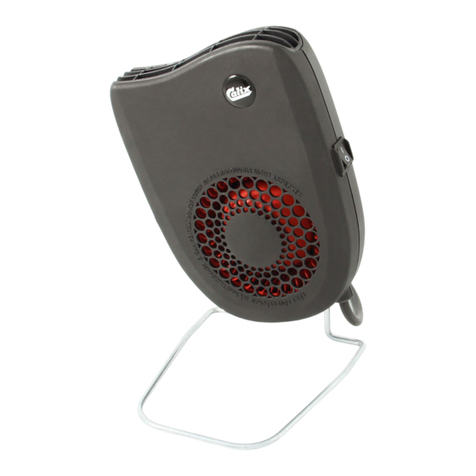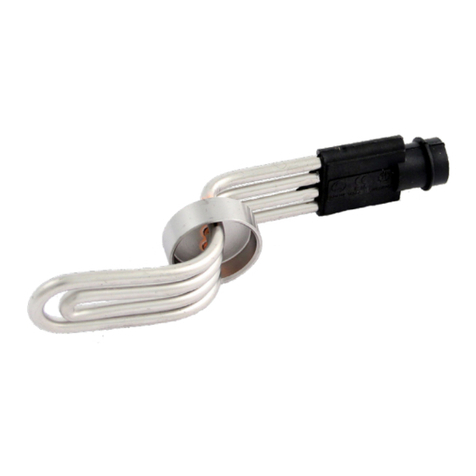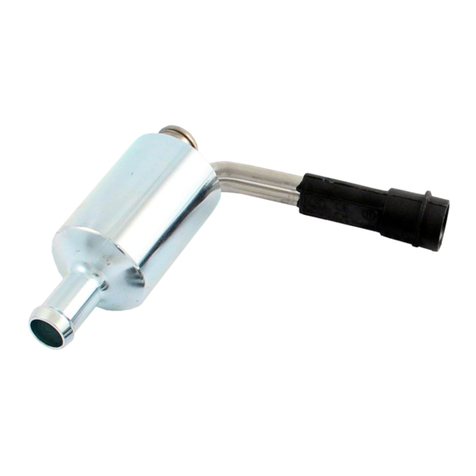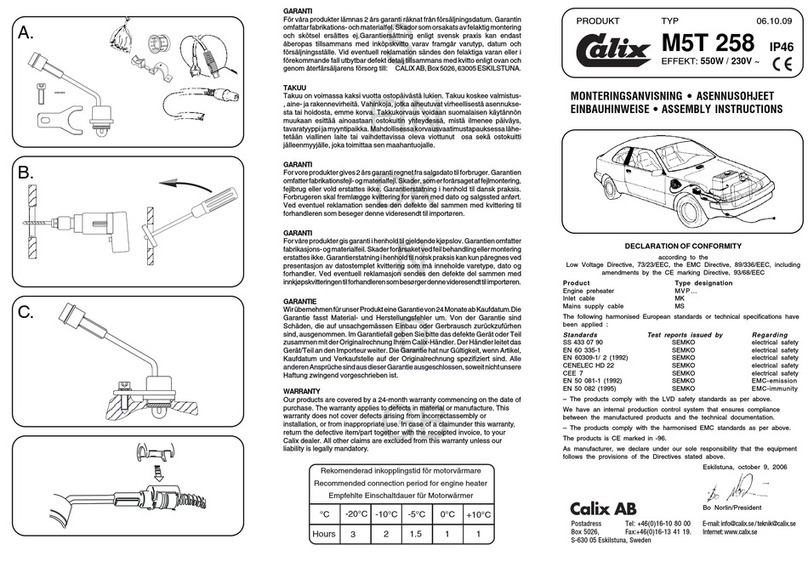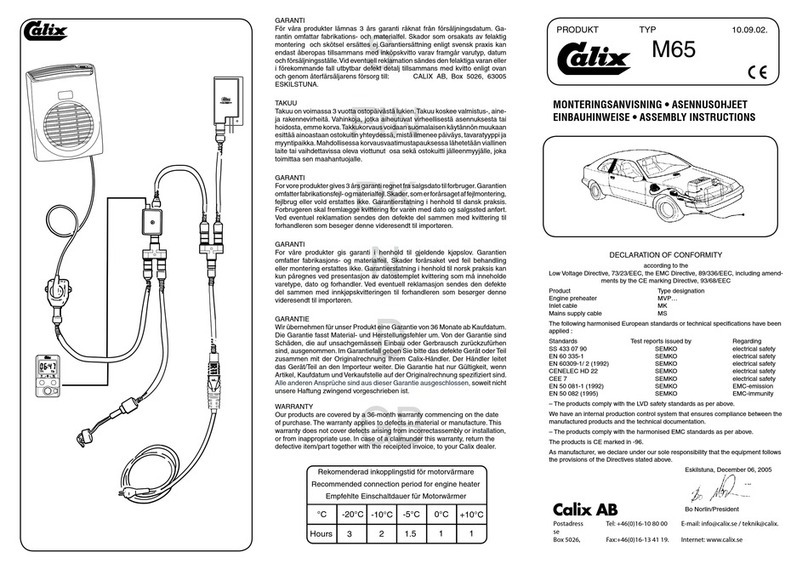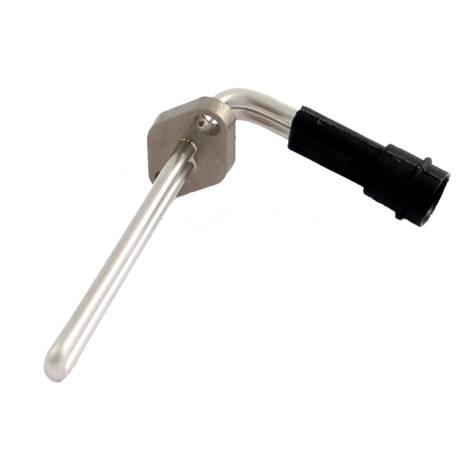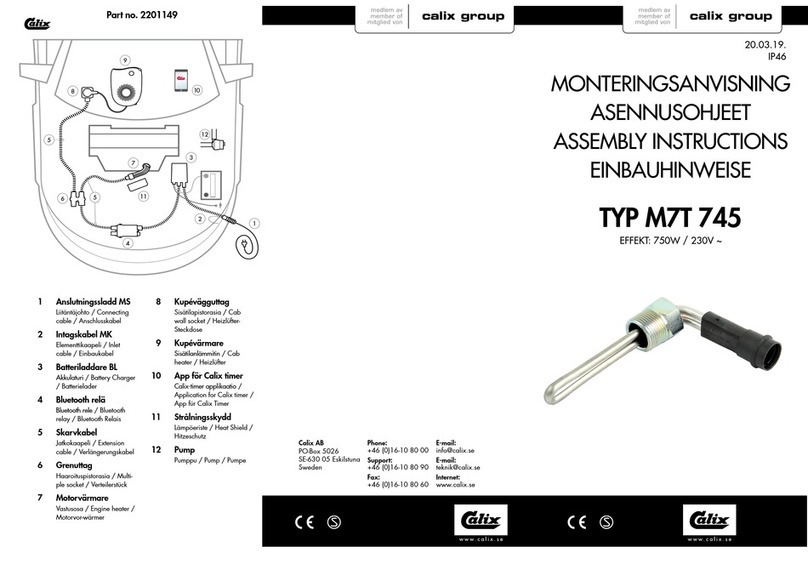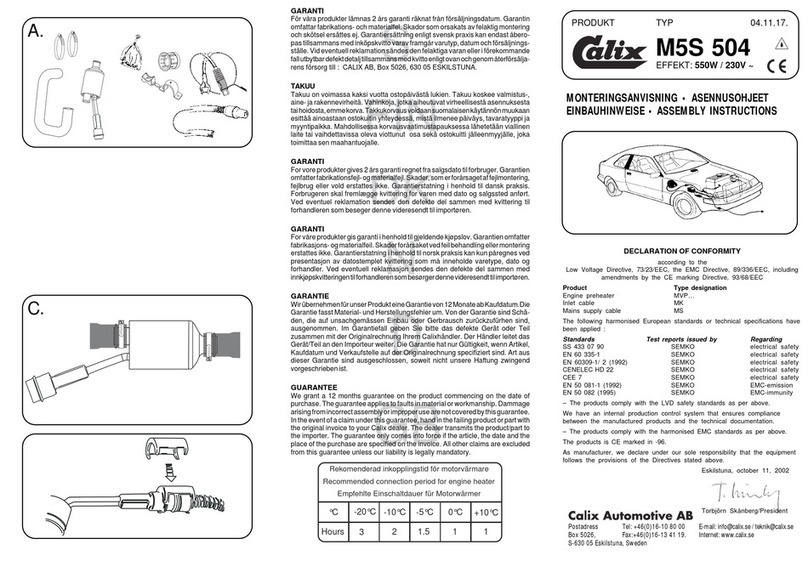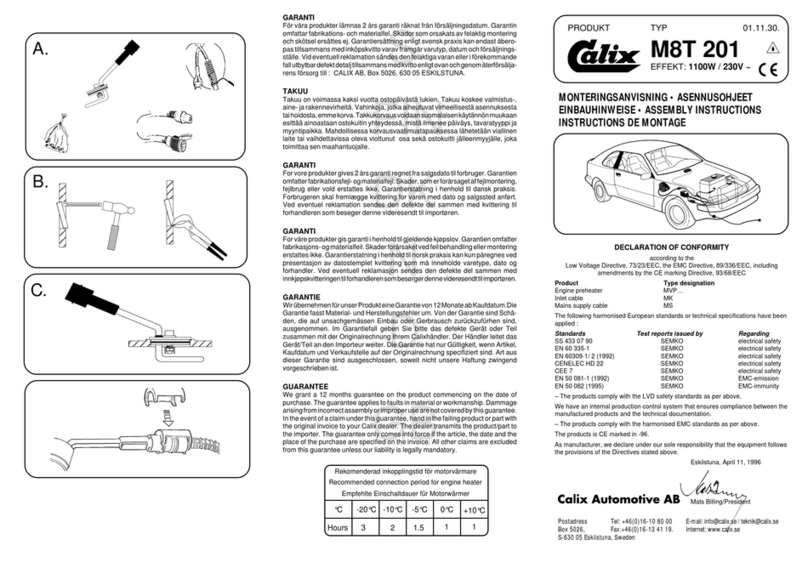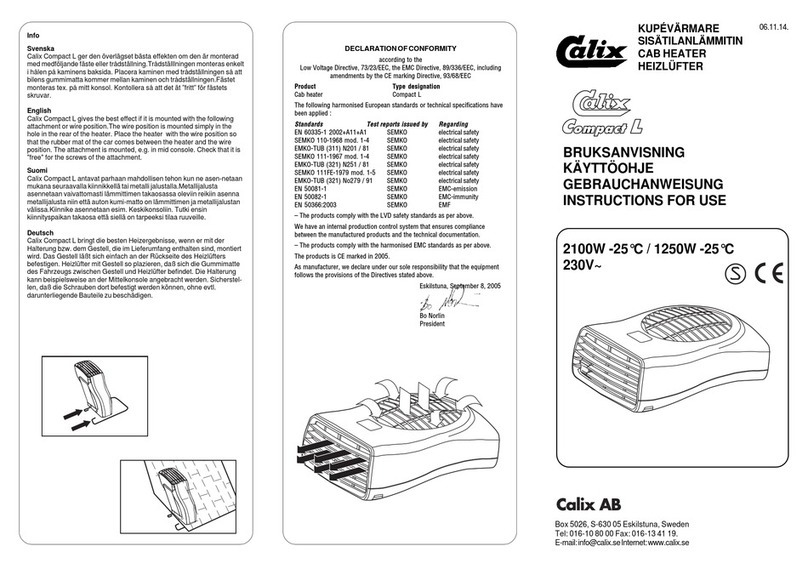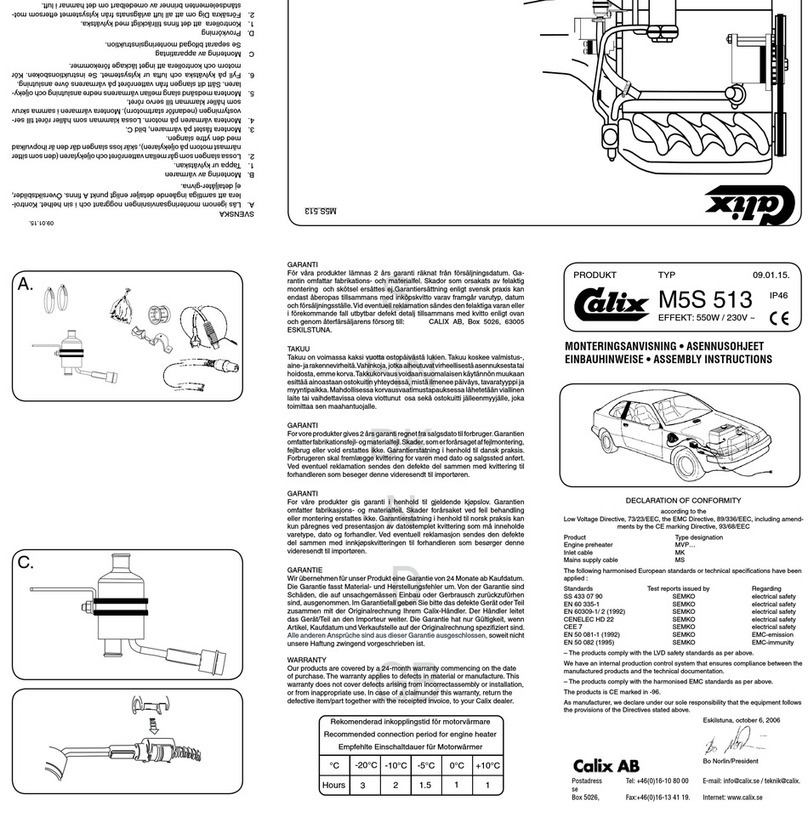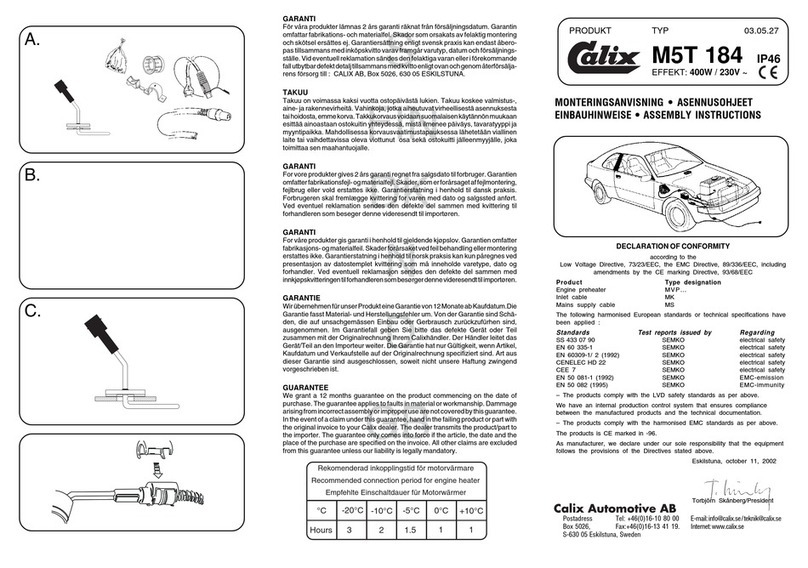
DEUTSCH
A. Einbauhinweisesorgfältigdurchlesen.SämtlicheDetailsinclusiveZubehörlaut
Pkt A kontrollieren. Nur zur Übersicht - keine Wiedergabe von Einzelheiten.
B. Einbau des Heizelementes
1. Kühlwasserablassen.
2. Verschlußschraube am Motorblock entfernen, siehe Bild.
3. Einbaukabel (mit Anbaustecker) von außen in den Motorraum ziehen.
SteckverbindungvonHeizungundKabelbiszumAnschlagineinanderschieben
O-Ring muß völlig dichtschließen. Zu beachten: Etwas Öl auf den O-Ring
geben.DieZusammenkupplungwirddannerleichtert.Verbindungmußunbedingt
auf diese Weise hergestellt werden.
4. Heizpatrone in das Loch einstecken und festziehen, Bild C. Gewinde mit
Dichtungsmassebestreichen.
5. Wasser einfüllen und Kühlsystem lüften. Hinweise der Kfz-Betriebsanleitung
beachten. Motor laufen lassen und Einbaustelle auf Dichtigkeit prüfen.
C. Einbau des steckers
1. Anbaustecker an einer Stelle befestigen, wo er weder durch Wasser noch
durch mechanische Einwirkung Schaden nehmen kann. Das Gehäuse hat
eine Vorpressung für ein Kondens-Dränloch (Pfeil). Ja nach Einbaustelle die
Vorpressung aufbrechen, damit in das Steckerinnere eindringendes Wasser
ablaufenkann.DieBefestigungsvorrichtungistausMetallsodasseineleitende
Verbindung (Erdung!) mit dem Fahrzeugrahmen ensteht.
Anbringung am Karosserieblech
Autoblech unter einem Befestigungsloch blankkratzen. Einzelteile wie folgt
zusammenfügen: Schraube, Zahnscheibe, Befestigungsloch, Zahnscheibe,
Autoblech, Pkt D.
Anbringung auf isolierender Unterlage, beispielsweise Kunststoff:
Halterung des Steckverbinders gemäß Abbildung D, mit durchgehender
SchraubeundMutterindernachstehendenReihenfolgebefestigen:Schraube,
Ringkabelschuh,Zahnscheibe,Steckverbinder,Mutter,isolierendeUnterlage,
Verstärkungsblech, Federscheibe, Mutter. Das andere Ende des Erdleiters
ist in der nachstehenden Reihenfolge mit dem Karosserieblech zu verbinden:
Blechschraube,Zahnscheibe,Ringkabelschuh,Zahnscheibe,Karosserieblech.
DerErdleiterdarfaufkeinenFallgekürtzwerden,sondernistanderKarosserie
festzuklemmen. Die Anbringung gemäß D gilt auch für vom Wagenchassis
isolierteBlechunterlagen.
D. Probelauf
1. Kühlwasserniveaukontrollieren.
2. Kühlsystem sorgfältig entlüften, da Heizpatrone sonst durchbrennen kann.
3. Dichtheit, auch bei warmen Motor überprüfen.
4. Nur eine geerdete Steckdose verwenden. Steckverbindungen überprüfen.
Funktion des Gerätes kontrollieren - beim Heizvorgang kann ein leichtes
Siedegeräuschvernommen werden.
E. Wichtig
1. Immer ausreichend Frostschutzmittel beimischen.
2. Motorheizer nur an eine geerdete Steckdose anschliessen. Der Mantel der
Motorheizung, die Karosserie und der Schutzleiter der Steckdose müssen
unbedingt leitend miteinander verbunden sein.
3. Die Anschlußleitung (zwischen Netzsteckdose und Anbaustecker) muß eine
ölbeständige Gummischlauchleitung (wie CEE (2) 57,3x1,5) sein. Sonstige
Ausfürung:SteckvorrichtungenausthermoplastischemKunststoff,wasserdicht.
Leitungsorgfältig behandelnund vorscharfen Kantenschützen, damitMantel
und Isolierung nicht beschädigt werden.
4. Das Kabel regelmäßig auf Beschädigungen oder Alterungserscheinungen
kontrollieren. Ein beschädigtes Kabel muß sofort ausgetauscht werden.
5. Installationsteile dürfen Motorenteile, die erwärmt werden oder in bewegung
sind,nicht berühren.Der Abstand zum Auspuffsystem sollmindestens 50mm
(auch bei Turbo-Aggregat) betragen - sonst den Calix Strahlungsschutz
verwenden.
6. Einbaukabel und eventuelle Verbindungskabel müssen dicht neben den
Verbindungsstecker mit den mitgelieferten Klammer befestigt werden.
F. Warnung
Abbrennen des Heizelementes (des Widerstandsdrahtes) kann erfolgen bei
• unsauberer Kühlflüssigkeit • ungenügenderKühlwassermenge
• nicht entlüftetem Kühlwassersystem • Verwendung von Kühlerzement
In diesen Fällen kann keine Garantileistung erfolgen.
ENGLISH
A. Read the assembly instructions carefully. Check that all parts and fittings
illustratedunder”A” areincluded.Surveyviewonly,withoutdetailedreproduction.
B. Installation of the heater
1. Drain the coolant.
2. Remove the threaded plug on the cylinder block (see the diagram).
3. Pull the cable with socket for the engine heater into the engine compartment.
Presstheplug-inconnectionbetweentheengineheaterandcablefullytogether
sothattheO-ringsealsproperlyandthereisnogap.Applyafewdropsofoilon
the O-ring. The connection can then be made easier. It is very important that
connection is made this way.
4. Insertthe engineheaterintheholeandtightenitniplace,figure C. Use sealing
compound on the thread.
5. Fil up with coolant and vent the cooling system, see the instruction book. Run
the engine and check that there is no leakage.
C. Fitting of lead-in
1. Fit the lead-in in a suitable place where it is protected from splashing and
mechanical damage. The lead-in has a thin section for drilling a drain hole for
condensationwater,seearrowunder”D”.Thismustbedrilledinsuchaposition
thatanywater whichhaspenetrated into the plugcavitycanrunout.The lead-
in is provided with metal attaching lugs for earthing to the vehicle chassis.
Fit the body panel
Removeallpaintanddirtfromthebodyworkunderoneoftheattachinglugsand
screw on the lead-in with the accompanying attaching parts in the following
order: self-tapping screw, toothed washer attaching lug, toothed washer and
body panel, see under ”D”.
Fitting of insulating material, e.g. plastic
Attach the retaining lug of the lead-in socket, see fig. D, with through-running
screw and nut in the following order: screw, ring terminal, toothed washer,
retaininglug, nut,insulating material, reinforcing plate, spring washer and nut.
Attach the other end of the earth lead on the body panel in the following order:
self-tapping screw, toothed washer, ring terminal, toothed washer and body
panel. On no account must the earth lead be cut off but should be clamped on
the body. Fitting according to fig. D also applies when fitting a panel which is
insulated from the car chassis.
D. Test-running
1. Check that the cooling system is full of coolant.
2. Makesurethatall airhasbeen removed fromthecooling system astheheater
element will immidiately burn out if surrounded by air.
3. Check that all seals are tight even with the engine warm.
4. Check the heater by connecting it to an earthed point. A low sizzling noise will
be heard when the water on the surface of the heater element boils.
E. Important
1. Always use anti-freeze in the cooling system.
2. The engine heater must only be connected to an earthed point. There must
alwaysbeacontinuousinternalearthconnectionrunningfromtheengineheater
casing through the body and right up to the earthed point.
3. Thecable between the lead-in andcontact plugmust beof oil-resistantrubber
hose of a type not lighter than RDO 3x1,5 mm2. The contact plug should be of
thermoplastic and of approved moisture-proof type. Take care not to damage
the cable, and particulary that doors, bonnet lid or other sharp objects do not
press against it so that the insulation is damaged.
4. Inspectthe cable periodicallyfordamageorageing.Adamagedcablemustbe
replaced without delay.
5. Nopartsoftheinstallationmustbeallowedtocomeintocontactwithmovingor
hotpartsoftheengine. The distancetoallpartsof the exhaustsystemmustbe
at least 50 mm (2”). (Also applicable for the turbo unit if any.) Otherwise Calix
Heat Shield must be used.
F. Warning
The heater element can be burnt out if:
• the coolant is dirty • there is insufficient coolant
• there is air in the system • there is sludge in the cooling system
• radiator cement is added to the coolant
In such cases the warranty is not valid.
FRANCAIS
A. Lire soigneusement la totalité des directives de montage. Verifier qu’il a
toutes les pièces selon point A. Vue d’ensemble seulement, sans
représentationdes détails.
B. Montage du réchauffeur du moteur
1. Vidanger le liquide de refroidissement.
2. Enlever le bouchon fileté de bloc moteur, voir fig.
3. Amener le cable de raccordement dans le compartiment moteur au niveau
deréchauffeur.Brancherbienàfondlecableavecleréchaffeurdefaçonque
labagued’étainschéitéfermehermetiquement.Appliquerquelquesgouttes
d’huile sur le joint torique. L’assemblage en est facilité. ATTENTION: Il est
très important que le branchement s’effectue de cette manière.
4. Insérerle réchauffeur dansletrouetleserrer,figureC.Appliquerduproduit
d´étainchéité sur le filetage.
5. Rajouterleliquidederéfroidissementetpurgerlesystèmederéfroidissement.
Voir livre d’instruction. Mettre le moteur en marche et verifier qu’il n’y a pas
de fuite.
C. Montage de la prise de raccord
1. Fixerlaprisederaccordà un endroitoùellenepeutêtre endommagé nipar
l’eau ni par des effets mécaniques. La prise comporte une préimpression
poureffectueruntroupermettantledrainagedelacondensation(voirflèche).
Selonl’emplacementdel’installationcasserlapré-impression,afinque l’eau
qui entrerait dans l’interieur de la prise puisse être évacuée. Lespartiesde
fixationsontenmetaldesortequ’ilseproduiseuneliasionconductrice(terre)
avec le chassis de la voiture.
Montagesurlatôledecarosserie(montagedeprisederaccordement).
Gratter à blanc la tôle de la voiture sous un trou de fixation. Assembler les
diversespièces comme suit:vis, rondelle´adents, troude fixation, rondelle
à dents, tôle de la voiture. Croquis point D.
Montage sur matériau isolant, plastique par example
Lorsdemontagesurlesmatériauxci-dessus,utiliserlerenfortentôle(fourni
à la livraison) pour stabiliser la prise de raccord. Visser l’anneau de fixation
de prise de raccordement (suivant figure D), avec vis traversante et écrou
dans l’ordre suivant: vis, cosse annulaire, rondelle dentée, anneau de
fixation,écrou, matériau isolant, renfort en tôle, rondelleélastique etécrou.
Visser la seconde extrémité du conducteur de terre à la tôle de carrosserie
dans l’ordre suivant: vis à tôle, rondelle dentée, cosse annulaire, rondelle
dentéeettôledecarrosserie.Leconducteurdeterrenedoitabsolumentpas
êtrecoupé etdoit êtreserré sur la carrosserie. Le montage suivant la figure
Destégalementvalablelorsdemontagesurtôleisoléeduchâsisautomobile.
D. Essai de fonctionnement
1. Vérifier qu’il y a suffisament de liquide de refroidissement.
2. Vérifier que l’air est complètement éliminé du système de refroidissement.
L’élément de resistance se casse immédiatement au contact de l’air.
3. Vérifier l’étanchéite également avec le moteur chaud.
4. Vérifier le fonctionement du réchauffeur en le raccordant à une prise avec
une mise à terre. On entend faiblement l’eau bouiller sur la surface du
réchauffeur.
E. Important
1. Utiliser toujours du liquide antigel dans le système de refroidissement.
2. Brancherleréchauffeuruniquementàunepriseavecmiseàterre.Toujours
veilleràceque, depuis laprisesursecteurjusqu’au réchauffeur, laliasionà
terre soit continue.
3. Lacablerelié au réseaudoitcomporter untuyauen caoutchouc, résistantà
l’huile et minimum de type *3x1,5 mm2avec une prise *CEE (2) 57 étanche
enthermoplasique.Manipulerlecableavecsoinafindenepasl’endommager
et créer ainsi des défauts d’isolation.
4. Vérifier régulièrement que le câble ne soit ni endommagé ni usé. Un câble
endommagé doit être changé immédiatement.
5. Aucun élément de l’installation ne doit toucher des parties chaudes ou
mobiles du compartiment moteur. La distance par rapport au système
d’échappement doit être au minimum de 50 mm. (Valable également pour
l’agregat de turbo.) Sinon utiliser la protection thermique Calix.
6. Les cables installés en permanence dans la voiture doivant être fixés avec
les agrafes ci-jointes le plus proche possible des points de raccordement.
F. Attention
Une coupure dans le fonctionnement du réchauffeur peut se produire si
• le liquide de refroidissement est sale
• la quantité de liquide de refroidissement n’est pas suffisante
• une présence d’air dans le système de refroidissement
• une présence de glace dans le système de refroidissement
• des produits d’obturation de fuites ont été utilisés dans le système de
refroidissement
Dans ces cas la garantie ne peut pas entrer en vigeur.
